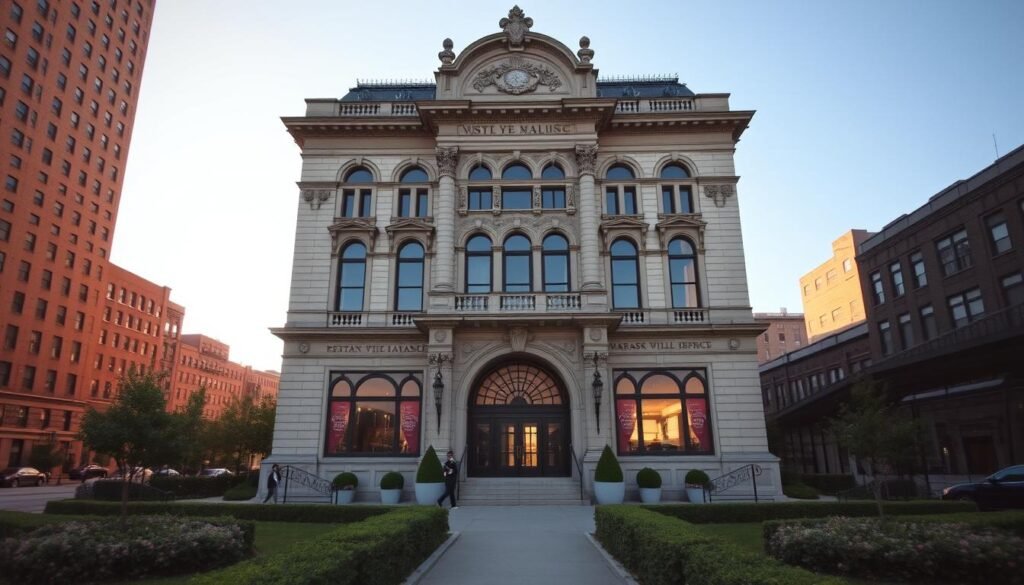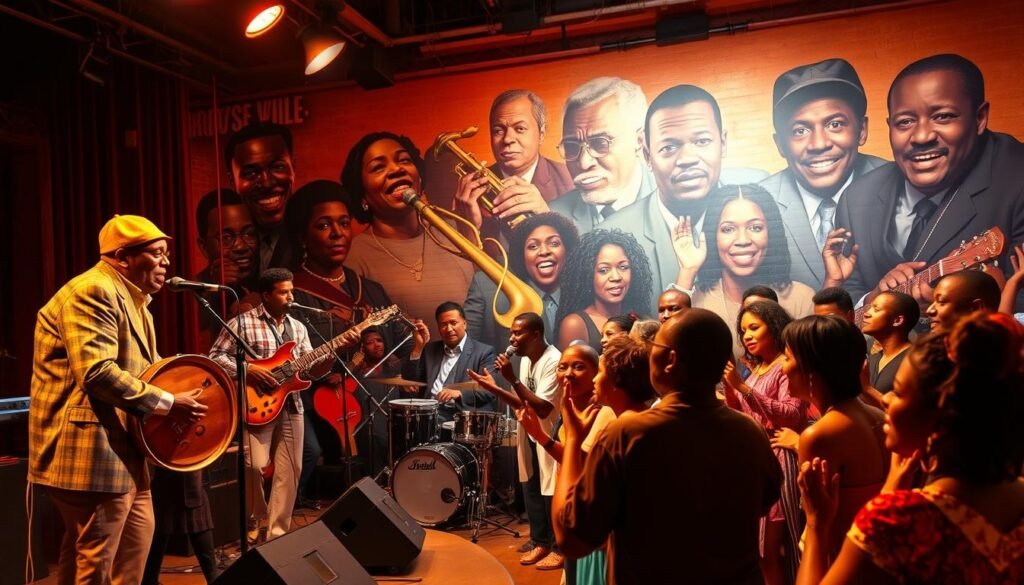Bronzeville Chicago history began as a dramatic surge in population during the Great Migration, when thousands arrived in a matter of years and reshaped an urban neighborhood.
The area sat about ten minutes south of downtown and formed a compact corridor from 31st Street to Pershing Road and the Dan Ryan to Lake Michigan. Residents responded to overcrowding and exclusion by building banks, newspapers, hospitals, and performance halls that lifted local life and influenced the whole country.
Today, preservation and new businesses balance pride and progress. Readers will explore how geography, policy, and community created institutions that defined culture, politics, and economic life. For an official overview of the heritage area and its sites, see the Bronzeville-Black Metropolis National Heritage Area.
Key Takeaways
- The neighborhood rose quickly during the Great Migration and formed a distinct south side identity.
- Residents built influential institutions that served local needs and shaped national discourse.
- Landmarks and cultural venues made the area a center for music, arts, and business.
- Restoration projects now pair preservation with economic revival and tourism.
- Understanding this area reveals how community, policy, and place interact to shape a city and country.
Origins Of The Black Metropolis On Chicago’s South Side
A narrow urban corridor on the south side concentrated new arrivals into a few crowded blocks. Over a short span of years, segregation and violence pushed many african americans into what became known as the black belt.
Defining The Black Belt: Boundaries From 31st To Pershing And Beyond To The Lake
The heart of the area is commonly described as 31st Street south to Pershing Road, from the Dan Ryan east to the lake. Some residents and scholars extend that zone farther north and south, but transit lines and job access explain the most cited limits.
Building Community Under Constraint: White-Owned Housing, Segregation, And Resilience
Beginning around 1916, housing discrimination forced many people into white-owned buildings that were crowded and often in poor repair. Rents could be higher in these units than in nearby white neighborhoods.
Rather than dissolve under pressure, residents pooled resources and created institutions. Churches, newspapers, banks, and theaters rose from limited homes and modest building stock. These organizations became essential lifelines for daily life and civic action.
“They converted constrained space into a platform for business, culture, and mutual aid.”
For an official teaching resource that explores how place and policy shaped this development, see this National Park Service guide.
Bronzeville Chicago History: Great Migration, Institutions, And National Influence
The Great Migration, starting in 1916, funneled thousands into southern neighborhoods where new institutions sprang up to meet pressing needs. Those moves transformed a local community into a national force in politics, medicine, finance, and the arts.
The Great Migration: African Americans Forge A New Life Starting In 1916
The influx of african americans after 1916 concentrated residents into tight areas where opportunity and discrimination met. Jobs in industry drew people north, but segregation limited housing and forced creative responses.
Pioneering Institutions: Chicago Defender, Chicago Bee, Binga Bank, And Provident Hospital
Newspapers like the Chicago Defender and Chicago Bee projected local concerns to the country and mobilized voters. Financial and medical firsts followed: Jesse Binga’s Binga Bank became a first black-owned financial center, while Provident Hospital advanced heart care under Daniel Hale Williams.

Wabash Avenue YMCA: Birthplace Of Black History Month And Civic Leadership
The wabash avenue ymca, built with local funds and Julius Rosenwald’s support, hosted Dr. Carter G. Woodson in 1915. That meeting helped launch what became Black History Month, beginning as a focused “Negro History Week” and later expanding into a nationally recognized history month.
Cultural Powerhouses: Savoy Ballroom-Regal Theater Complex And The Sunset Cafe
Entertainment venues anchored a thriving music scene. Jazz and gospel flourished at the Savoy-Regal complex and the Sunset Cafe, creating a cultural center that rivaled other famous performance hubs.
“A single building can seed movements that reach the city and the country.”
- The great migration drove population change and institutional growth.
- Local newspapers and banks gave the neighborhood national reach.
- The avenue ymca became a training and civic hub that shaped scholarship and public observance.
- Music venues turned the area into a lasting cultural center.
For a deeper look at the area’s roots and institutions, see the history of the area and a broader account of its role as a hub of Black business and culture.
Cultural Legacy: Music, Arts, And Trailblazers Who Shaped A Nation
A concentrated network of performance halls and meeting houses launched careers that reshaped American culture. Local stages, churches, and art spaces trained artists who carried new sounds and ideas beyond the neighborhood.

From Jazz To Gospel: Louis Armstrong, Nat “King” Cole, And Mahalia Jackson
Jazz pioneers and vocal innovators refined their craft on local stages. Louis Armstrong and Nat “King” Cole helped define jazz rhythms while Mahalia Jackson propelled gospel music into public life.
Voices And Visionaries: Ida B. Wells, Gwendolyn Brooks, Richard Wright, And Bessie Coleman
Writers and activists like ida wells and gwendolyn brooks used prose and poetry to challenge injustice. Richard Wright and others amplified african americans’ experiences. Bessie Coleman broke aviation barriers, widening the field of possibility.
Hubs Of Art And Learning: South Side Community Art Center, Mecca Flats, And Illinois Institute Of Technology
The South Side Community Art Center became the oldest Black art center in the U.S. Mecca Flats and the illinois institute technology campus tied architectural memory to community life. Galleries, buildings, and homes doubled as classrooms that nurtured talent across generations.
“Local stages and sacred spaces carried traditions forward while mentoring the next wave of creators.”
From Expressway Disruption To Economic Revival And Preservation
Mid-century roadbuilding and industry shifts carved new physical and social divides through the south side neighborhood.
The construction of the Dan Ryan Expressway in the late 1950s bisected blocks and, with factory relocations, accelerated population decline. Large public housing projects such as the Robert Taylor Homes and Stateway Gardens concentrated poverty near the ryan expressway corridor.
Dan Ryan Expressway And Mid-Century Change: Population Shifts And Public Housing
Disinvestment followed the new highway and deindustrialization. Streets that once supported small shops and steady foot traffic lost customers.
Revitalization Today: Restored Landmarks, Local Businesses, And Inclusive Growth
Community leaders organized in the 1990s, and the city later invested millions to repair infrastructure and public space. Preservation efforts saved the original Chicago Defender and Chicago Bee buildings, the wabash avenue ymca, Unity Hall, and the Supreme Life Building.
Restored landmarks now sit alongside active businesses such as Bronzeville Winery, Sip & Savor (and Turner Haus Brewery), and Thee Beauty Bar. Bronzeville residents lead cultural programming so that shop owners and creatives share gains with long-term homeowners.

Preservation keeps living memory visible: Provident Hospital and other anchors remind visitors that medical innovation and first black-owned legacies remain at the heart of neighborhood life.
- The dan ryan era reshaped patterns and prompted community mobilization.
- Restored buildings and new businesses illustrate inclusive growth today.
- Residents balance the past and present so culture and commerce advance together.
Conclusion
This neighborhood’s restored landmarks show how a local civic space can shape national memory. The Wabash Avenue avenue ymca helped launch observances that evolved into black history month, leading to federal recognition in 1976 and a place on the National Register of Historic Places.
Figures like ida wells, gwendolyn brooks, and bessie coleman left lasting marks on culture, law, and flight. Media institutions such as the chicago defender and chicago bee show how local reporting shaped the country. Music—jazz and gospel music—still threads community life while learning hubs like the illinois institute technology link scholarship to opportunity.
For a practical look at neighborhoods, see this Bronzeville neighborhood overview that highlights landmarks, businesses, and residents who carry the legacy forward.
